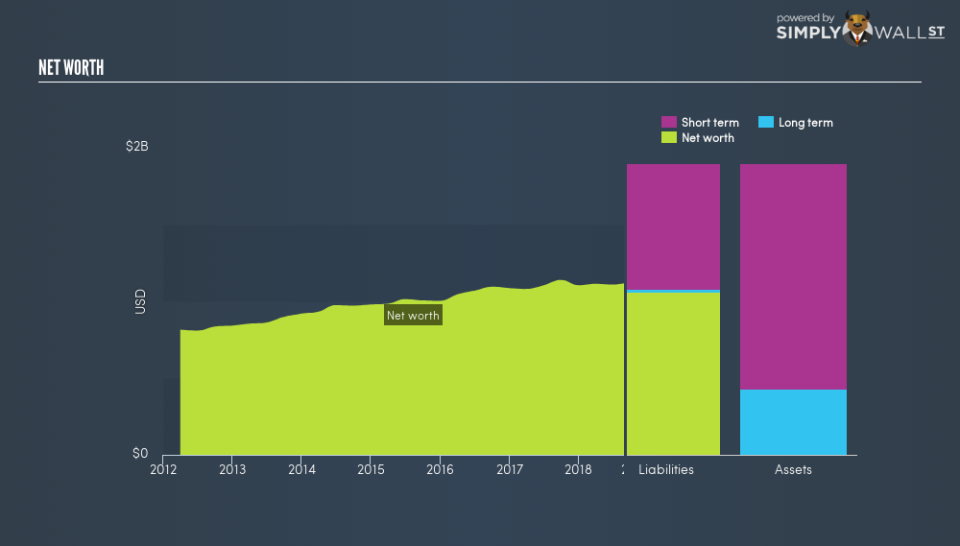Should Investors Be Happy About Robert Half International Inc.’s (NYSE:RHI) Cash Levels?

Want to participate in a short research study? Help shape the future of investing tools and receive a $20 prize!
If you are currently a shareholder in Robert Half International Inc. (NYSE:RHI), or considering investing in the stock, you need to examine how the business generates cash, and how it is reinvested. This difference directly flows down to how much the stock is worth. Operating in the industry, RHI is currently valued at US$8.0b. I will take you through RHI’s cash flow health and the risk-return concept based on the stock’s cash flow yield, using the most recent financial data. This will help you think about the company from a cash perspective, which is a crucial factor to investing.
View our latest analysis for Robert Half International
Is Robert Half International generating enough cash?
Robert Half International’s free cash flow (FCF) is the level of cash flow the business generates from its operational activities, after it reinvests in the company as capital expenditure. This type of expense is needed for Robert Half International to continue to grow, or at least, maintain its current operations.
There are two methods I will use to evaluate the quality of Robert Half International’s FCF: firstly, I will measure its FCF yield relative to the market index yield; secondly, I will examine whether its operating cash flow will continue to grow into the future, which will give us a sense of sustainability.
Free Cash Flow = Operating Cash Flows – Net Capital Expenditure
Free Cash Flow Yield = Free Cash Flow / Enterprise Value
where Enterprise Value = Market Capitalisation + Net Debt
Robert Half International’s yield of 5.81% last year indicates its ability to produce cash at the same rate as the market index, taking into account the company’s size. However, given that the risk for holding single-stock Robert Half International is higher, this may mean inadequate compensation above and beyond merely investing in the whole market.
Is Robert Half International’s yield sustainable?
Does RHI’s future look brighter in terms of its ability to generate higher operating cash flows? This can be estimated by examining the trend of the company’s operating cash flow moving forward. In the next couple of years, the company is expected to grow its cash from operations at a single-digit rate of 8.8%, increasing from its current levels of US$572m to US$623m in two years’ time. Although this seems impressive, breaking down into year-on-year growth rates, RHI’s operating cash flow growth is expected to decline from a rate of 6.9% in next year, to 1.8% in the following year. But the overall future outlook seems buoyant if RHI can maintain its levels of capital expenditure as well.
Next Steps:
Robert Half International is compensating investors at a cash yield similar to the wider market portfolio. But, in saying this, investors are taking on more risk by buying one single stock as opposed to a diversified market portfolio, but they are being compensated at the same level. Not the best deal! Keep in mind that cash is only one aspect of investment analysis and there are other important fundamentals to assess. I recommend you continue to research Robert Half International to get a better picture of the company by looking at:
Valuation: What is RHI worth today? Is the stock undervalued, even when its growth outlook is factored into its intrinsic value? The intrinsic value infographic in our free research report helps visualize whether RHI is currently mispriced by the market.
Management Team: An experienced management team on the helm increases our confidence in the business – take a look at who sits on Robert Half International’s board and the CEO’s back ground.
Other High-Performing Stocks: If you believe you should cushion your portfolio with something less risky, scroll through our free list of these great stocks here.
We aim to bring you long-term focused research analysis driven by fundamental data. Note that our analysis may not factor in the latest price-sensitive company announcements or qualitative material.
If you spot an error that warrants correction, please contact the editor at editorial-team@simplywallst.com. This article by Simply Wall St is general in nature. It does not constitute a recommendation to buy or sell any stock, and does not take account of your objectives, or your financial situation. Simply Wall St has no position in the stocks mentioned. On rare occasion, data errors may occur. Thank you for reading.
